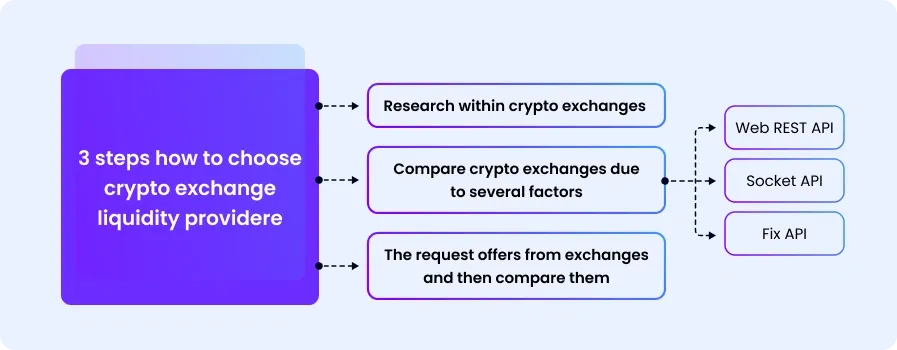How to spot top crypto liquidity providers and choose the best of them
What is liquidity?
Liquidity is a financial term of how easily the investment can be exchanged into cash. To show it by example, let’s take a look at two different markets in terms of liquidity, real estate, and forex market. When anyone wants to sell a property like a house or a parcel, there can be a waiting time within a few days, weeks, or even months, until the demand is found and the deal is done. On the other hand, forex market trading, for example when trading US Dollar vs. EURO, trade could be executed within minutes, or even seconds.
High liquid markets can absorb large transactions without a price slippage. This is an effective way for a customer to trade effectively, to use liquid markets instead of illiquid.
Who can be a liquidity provider?
A liquidity provider (or LP) can be anyone, who offers to the market one of the most important things: liquidity. In the traditional stock business, they are market makers: investment companies, principal trading firms, institutional investors such as big banks or hedge funds, that trade with enormous amounts of assets. They provide to the market a possibility of executing the trade immediately, without waiting for a counterparty that would accept the trader’s proposal, in the exchange terms bid or ask.
Mostly they are fully regulated and watched by governments to play transparently and follow guidelines and laws.
LPs generate liquidity in a way that they take a counter position to the users' order on the market. It might even seem that they take a loss, while they accept the offered price, but even a small loss is counted in their strategy, because they trade in such huge amounts, that one small loss count plays a role in the long run.
What role of liquidity in the brokerage business?
Liquidity is a key factor for brokerage and exchange business success. As said earlier, an important role for providing a solid amount of liquidity is the usage of a provider for a broker or even several providers.
By using a crypto exchange provider, an exchange or a broker can offer a tighter spread to the customer. This is an important issue for users when they are deciding where to trade – if by a broker/exchange with good liquidity or at an illiquid market. Most rational thinking users would pick higher liquidity because it makes their trades more efficient and profitable.
3 steps how to choose crypto exchange liquidity provider
Cryptocurrency trading has its specifics in comparison to traditional markets or forex because the high liquid cryptocurrency signals the interest of various investors and thus could also play an important role in the development of the specific cryptocurrency. As some investors say, the price is the most important marketing in crypto and low volatile crypto could be easily manipulated and cut on trustworthiness by being an object for pump&dump groups.

There are 3 important steps, how to find the top crypto provider for a broker so let’s focus on those for now.
Research within crypto exchanges
Go and find the most popular cryptocurrency exchanges on the internet. Check the ratings, exchange reviews, legal requirements, as well as the trading volume on the exchanges. Relevant characteristics are as well the pricing and economic efficiency of exchange and its trading infrastructure.
The key is to select the most trusted exchanges because from this decision you will benefit in the future. After all, a trustworthy partner will remain stable through strange times and low volatile periods.
Compare crypto exchanges due to several factors
After the research is done, it’s important to compare the results to get the top crypto providers for your business. The most valuable characteristics should be the number of instruments, terms of trade, availability of margin trading, protocols used. From them, pick the most convenient cryptocurrency exchange that would serve your needs.
From the protocols that use crypto exchanges, those are the most important and definitely should be on the list of the exchange that you will pick as your cryptocurrency liquidity provider.
Web REST API
Representational state transfer (REST) is a standard for a variety of web services. It enables exchanges of full asset management functionality including trading, private account data, trades data, public order books, and order management. From the three mentioned protocols it’s the least responsive one.
Socket API
Socket API improves web service effectiveness. It allows sending messages and receiving market and account data thanks to streaming functionality pursuant to WebSocket protocol. WebSocket should be the most efficient for pushing the real-time market data.
Fix API
Financial Information eXchange (FIX) is a standard protocol that allows placing orders, submitting cancel requests, and receiving fills. Using FIX messages is probably the most effective way to communicate between the exchange and its provider.
Fix API provides the best performance of order management from these three mentioned protocols. A set of Fix bridge providers combined with the trading ecosystem is frequently used by the top providers.
The request offers from exchanges and then compare them
After having the comparison done, there is a time to request offers from chosen exchanges. After they will hand over their offers, compare them with several different characteristics such as pricing, fees, and cooperation terms. The one that suits them best to your requirements would be the best pick for you. The comparison table could then look similar to this one, of course with the characteristics that are most important to you.
Prime of prime scheme
The Forex industry has a long-established scheme of working with providers — Prime of Prime, or PoP. It implies the engagement of the services of some tech company, which either aggregates liquidity from several sources or is itself a client of Tier 1 providers — for example, the world's major banks like HSBC. So you, as a partner of such a tech company, have access to quality liquidity that would not otherwise be available to you.
On the other hand, such an approach entails a state of both technological and business dependence on one's failure. You have no control of the work of the hardware and software components of the aggregation process, and you cannot be sure that your tech partner will not want to break off cooperation with you because of dissatisfaction with the performance of a particular financial flow.
Prime of prime in the crypto industry is a company that offers to brokers and exchanges a trading liquidity pool of selected top-rated exchanges. A client of Prime of prime can then take advantage of the huge liquidity offered by PoP aggregated feed.
Liquidity aggregation
Simply put, liquidity aggregation is the process of combining offers to buy or sell an asset from different sources and directing them to executors. The purpose of aggregation is to enable traders to buy an asset as close to market prices as possible.
For instance, due to the strong volatility of the cryptocurrency market, the price of the asset on different platforms can vary greatly. And if a trader is not satisfied with the price of orders to buy a particular cryptocurrency on an exchange, they have two choices — either to accept the existing situation, or switch the exchange.
Switching the exchange looks like a logical solution, but even then there is no guarantee that when coming to another exchange, the trader will catch the desired price of the asset. The solution is liquidity aggregation. If some exchange connects a liquidity aggregator for that, it will be able to collect profitable orders to sell cryptocurrency from other providers and deliver them to clients, thus attracting more traders. A liquidity aggregator is a tool that units buy and sell orders from different liquidity providers through the API access into one liquidity pool. So when you use a liquidity aggregator, you get the kind of technological and business flexibility that you can't achieve with the Prime of Prime scheme described above.
“Any trading platform that wants only the good for its clients must have high-quality liquidity provided through fast and secure channels. The more providers are available, the deeper the liquidity and the better conditions that can be offered to traders.“
Learn more: Crypto Liquidity Aggregator
Advantages of having more liquidity providers
Having multiple providers of liquidity and aggregating them into one account is a big advantage for the exchange business. This is why having your liquidity aggregator is such a niche.
It also applies to the large institutional investors, because in their case, big orders of their clients wouldn’t have that affect on the spot price on that specific exchange, while using many different providers at once. This makes the clients' trades more efficient, without unwanted slippage. Liquidity aggregators benefit both traders and the trading platform.
Conclusion
Trading nowadays is such a different game, than trading a few years ago. Users can now trade more effectively without a possible chance of slippage, even when they trade big amounts of assets.
Liquidity aggregators can now unit an unlimited amount of liquidity providers, which allows traders to do the best deal on the market possible. And that’s what they want!
If you have your crypto exchange or thinking about building one, liquidity aggregation is a must to boost its performance and efficiency. Without it, you can’t benefit from the liquidity from several providers and that's the current name of the game. To provide your clients the highest degree of liquidity possible and that isn’t possible by using just one provider.
If you would like detailed advice on which type of liquidity management is right for your business, please leave a request.
Submit a request



